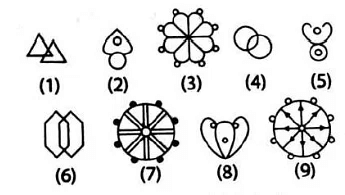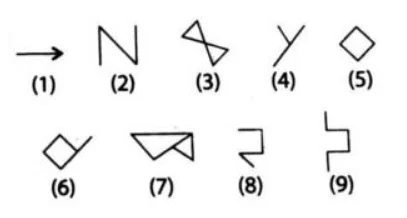Worksheet Solutions: Grouping | Know Your Aptitude Class 3 To 5 - Class 5 PDF Download
Q1: In the following question, group the given figures into three classes using each figure only once.
Problem Figure: (a) (1, 3, 4) (2, 5, 9) (6, 7, 8)
(a) (1, 3, 4) (2, 5, 9) (6, 7, 8)
(b) (1, 2, 3) (4, 5, 6) (7, 8, 9)
(c) (1, 5, 9) (2, 4, 7) (3, 6, 8)
(d) (3, 7, 8) (1, 6, 5) (4, 2, 9)
Ans: (a)
Explanation: If we start grouping the figures on the basis of sides, we have:
The figures that are made by three lines are (1, 3, 4)
Also, the figures which are made by four lines are (6, 7, 8)
Similarly, the figures made by the five lines are (2, 5, 9). These three groups are present in the option a. Thus the answer is a.
Q2: In the following question, group the given figures into three classes using each figure only once.
Problem Figure: (a) (1, 4, 7) (2, 5, 8) (3, 6, 9)
(a) (1, 4, 7) (2, 5, 8) (3, 6, 9)
(b) (1, 3, 6) (2, 5, 8) (4, 7, 9)
(c) (1, 2, 4) (3, 5, 8) (6, 7, 9)
(d) (1, 4, 9) (2, 5, 8) (3, 6, 7)
Ans: (a)
Explanation: There are figures that have one small and one big circle are figure 1, figure 4, and figure 7. Figures which have one sharp point are the figure2, figure 5, and figure 8. Also, the figures that have shapes like buckets are the figure 3, figure 6, and figure 9.
Q3: In the following question, group the given figures into three classes using each figure only once.
Problem Figure:
(a) (1, 2, 3) (4, 8, 9) (5, 7, 6)
(b) (4, 5, 7) (3, 1, 2) (7, 8, 9)
(c) (1, 2, 7) (8, 9, 4) (2, 3, 6)
(d) (3, 5, 6) (8, 7, 4) (9, 1, 2)
Ans: (c)
Explanation: The figures 1, 3 and 7 have three petals.three rectangles and three triangles respectively. So, they should be grouped in one group figures 4, 8 and 9 have one triangle, one rectangle and one circle respectively. So, they should be grouped into one group. On the other hand, the figures between 2, 5 and 6 have five petals, five triangles and five squares, respectively. So, they should be grouped into one group. Therefore the correct answer is (c) (1, 2, 7) (8, 9, 4) (2, 3, 6).
Q4: In the following question, group the given figures into three classes using each figure only once.
Problem Figure: (a) (1, 4, 8) (2, 5, 7) (3, 9, 6)
(a) (1, 4, 8) (2, 5, 7) (3, 9, 6)
(b) (1, 4, 6) (2, 5, 8) (3, 7, 9)
(c) (1, 4, 6) (2, 5, 7) (3, 8, 9)
(d) (1, 2, 3) (4, 5, 6) (7, 8, 9)
Ans: (b)
Explanation: The figures 1, 4 and 6 have two triangles, two circles and two hexagons, respectively. Figures 2, 5 and 8 are similar in shape. In figures 3, 7 and 9 there are eight small circles around a big circle. Now let us move on to more solved examples on the Grouping of Figures.
Q5: In the following question, group the given figures into three classes using each figure only once.
Problem Figure: (a) (1, 5, 6) (2, 3, 4) (7, 8, 9)
(a) (1, 5, 6) (2, 3, 4) (7, 8, 9)
(b) (1, 2, 4) (3, 5, 8) (6, 7, 9)
(c) (5, 6, 7) (1, 2, 4) (3, 8, 9)
(d) (1, 2, 4) (3, 5, 7) (6, 8, 9)
Ans: (b)
Explanation: In the question figure we see that the figures that we label 1, 2 and 4 all consist of three lines. Also, the figures 3, 5 and 8 all consist of four lines each. Similarly, we can see that the figures 6, 7 and 9 all consist of five lines. Therefore this gives us the grouping of the figures.
Q6: In the following question, group the given figures into three classes using each figure only once.
Problem Figure: (a) (1, 7, 8) (2, 6, 5) (3, 4, 9)
(a) (1, 7, 8) (2, 6, 5) (3, 4, 9)
(b) (1, 8, 9) (2, 3, 5) (4, 6, 7)
(c) (2, 3, 5) (1, 7, 8) (4, 6, 9)
(d) (2, 6, 7) (1, 3, 4) (5, 8, 9)
Ans: (c)
Explanation: As is clear from the question figure, the figures 2, 3 and 5 have one point or in other words, we can say that they are a one-pointed system. Also, we can see that the figures 1, 8 and 9 are made up of four lines.
|
10 videos|45 docs|3 tests
|

|
Explore Courses for Class 5 exam
|

|

















